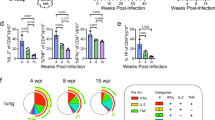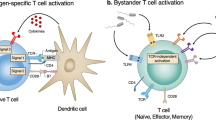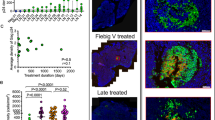Abstract
Some individuals who are infected with HIV rapidly deteriorate shortly after starting antiretroviral therapy, despite effective viral suppression. This reaction, referred to as immune reconstitution inflammatory syndrome (IRIS), is characterized by tissue-destructive inflammation and arises as CD4+ T cells re-emerge. It has been proposed that IRIS is caused by a dysregulation of the expanding population of CD4+ T cells specific for a co-infecting opportunistic pathogen. Here, we argue that IRIS instead results from hyper-responsiveness of the innate immune system to T cell help, a mechanism that may be shared by the many manifestations of IRIS that occur following the reversal of other types of immunosuppression in pathogen-infected hosts.
This is a preview of subscription content, access via your institution
Access options
Subscribe to this journal
Receive 12 print issues and online access
$209.00 per year
only $17.42 per issue
Buy this article
- Purchase on SpringerLink
- Instant access to full article PDF
Prices may be subject to local taxes which are calculated during checkout


Similar content being viewed by others
References
Zolopa, A. et al. Early antiretroviral therapy reduces AIDS progression/death in individuals with acute opportunistic infections: a multicenter randomized strategy trial. PLoS ONE 4, e5575 (2009).
Abdool Karim, S. S. et al. Timing of initiation of antiretroviral drugs during tuberculosis therapy. N. Engl. J. Med. 362, 697–706 (2010).
Castelnuovo, B. et al. Cause-specific mortality and the contribution of immune reconstitution inflammatory syndrome in the first 3 years after antiretroviral therapy initiation in an urban african cohort. Clin. Infect. Dis. 49, 965–972 (2009).
Abdool Karim, S. S. et al. Integration of antiretroviral therapy with tuberculosis treatment. N. Engl. J. Med. 365, 1492–1501 (2011).
Hoyo-Ulloa, I. et al. Impact of the immune reconstitution inflammatory syndrome (IRIS) on mortality and morbidity in HIV-infected patients in Mexico. Int. J. Infect. Dis. 15, e408–e414 (2011).
Blanc, F.-X. et al. Earlier versus later start of antiretroviral therapy in HIV-infected adults with tuberculosis. N. Engl. J. Med. 365, 1471–1481 (2011).
Havlir, D. V. et al. Timing of antiretroviral therapy for HIV-1 infection and tuberculosis. N. Engl. J. Med. 365, 1482–1491 (2011).
French, M. A. et al. Immune restoration disease after the treatment of immunodeficient HIV-infected patients with highly active antiretroviral therapy. HIV Med. 1, 107–115 (2000).
Ratnam, I., Chiu, C., Kandala, N.-B. & Easterbrook, P. J. Incidence and risk factors for immune reconstitution inflammatory syndrome in an ethnically diverse HIV type 1-infected cohort. Clin. Infect. Dis. 42, 418–427 (2006).
Murdoch, D. M., Venter, W. D. F., Feldman, C. & Van Rie, A. Incidence and risk factors for the immune reconstitution inflammatory syndrome in HIV patients in South Africa: a prospective study. AIDS 22, 601–610 (2008).
Grant, P. M. et al. Risk factor analyses for immune reconstitution inflammatory syndrome in a randomized study of early vs. deferred ART during an opportunistic infection. PLoS ONE 5, e11416 (2010).
Breton, G. et al. Immune reconstitution inflammatory syndrome in HIV-infected patients with disseminated histoplasmosis. AIDS 20, 119–121 (2006).
Nolan, R. C., Chidlow, G. & French, M. A. Parvovirus B19 encephalitis presenting as immune restoration disease after highly active antiretroviral therapy for human immunodeficiency virus infection. Clin. Infect. Dis. 36, 1191–1194 (2003).
Connick, E., Kane, M. A., White, I. E., Ryder, J. & Campbell, T. B. Immune reconstitution inflammatory syndrome associated with Kaposi sarcoma during potent antiretroviral therapy. Clin. Infect. Dis. 39, 1852–1855 (2004).
Mueller, M. et al. Immune reconstitution inflammatory syndrome in patients starting antiretroviral therapy for HIV infection: a systematic review and meta-analysis. Lancet Infect. Dis. 10, 251–261 (2010).
Manabe, Y. C., Campbell, J. D., Sydnor, E. & Moore, R. D. Immune reconstitution inflammatory syndrome: risk factors and treatment implications. J. Acquir. Immune Defic. Syndr. 46, 456–462 (2007).
Meintjes, G. et al. Tuberculosis-associated immune reconstitution inflammatory syndrome: case definitions for use in resource-limited settings. Lancet Infect. Dis. 8, 516–523 (2008).
Bourgarit, A. et al. Explosion of tuberculin-specific Th1-responses induces immune restoration syndrome in tuberculosis and HIV co-infected patients. AIDS 20, F1–F7 (2006).
Bourgarit, A. et al. Tuberculosis-associated immune restoration syndrome in HIV-1-infected patients involves tuberculin-specific CD4 Th1 cells and KIR-negative γδ T cells. J. Immunol. 183, 3915–3923 (2009).
Meintjes, G. et al. Type 1 helper T cells and FoxP3-positive T cells in HIV-tuberculosis-associated immune reconstitution inflammatory syndrome. Am. J. Respir. Crit. Care Med. 178, 1083–1089 (2008).
Roths, J. B., Marshall, J. D., Allen, R. D., Carlson, G. A. & Sidman, C. L. Spontaneous Pneumocystis carinii pneumonia in immunodeficient mutant scid mice. Natural history and pathobiology. Am. J. Pathol. 136, 1173–1186 (1990).
Roths, J. B. & Sidman, C. L. Both immunity and hyperresponsiveness to Pneumocystis carinii result from transfer of CD4+ but not CD8+ T cells into severe combined immunodeficiency mice. J. Clin. Invest. 90, 673–678 (1992).
Roths, J. B. & Sidman, C. L. Single and combined humoral and cell-mediated immunotherapy of Pneumocystis carinii pneumonia in immunodeficient scid mice. Infect. Immun. 61, 1641–1649 (1993).
Gigliotti, F., Xu, H. & Wright, T. Contribution of T cell subsets to the pathophysiology of Pneumocystis-related immunorestitution disease. Am. J. Physiol. Lung Cell. Mol. Physiol. 291, L1256–L1266 (2006).
Atochina-Vasserman, E. N. et al. Immune reconstitution during pneumocystis lung infection: disruption of surfactant component expression and function by S-nitrosylation. J. Immunol. 182, 2277–2287 (2009).
French, M. A., Mallal, S. A. & Dawkins, R. L. Zidovudine-induced restoration of cell-mediated immunity to mycobacteria in immunodeficient HIV-infected patients. AIDS 6, 1293–1297 (1992).
Barber, D. L. et al. Th1-driven immune reconstitution disease in Mycobacterium avium-infected mice. Blood 116, 3485–3493 (2010).
Elliott, J. H. et al. Immunopathogenesis and diagnosis of tuberculosis and tuberculosis-associated immune reconstitution inflammatory syndrome during early antiretroviral therapy. J. Infect. Dis. 200, 1736–1745 (2009).
Antonelli, L. R. V. et al. Elevated frequencies of highly activated CD4+ T cells in HIV+ patients developing immune reconstitution inflammatory syndrome. Blood 116, 3818–3827 (2010).
Tan, D. B. A. et al. TLR2-induced cytokine responses may characterize HIV-infected patients experiencing mycobacterial immune restoration disease. AIDS 25, 1455–1460 (2011).
Krupica, T., Fry, T. J. & Mackall, C. L. Autoimmunity during lymphopenia: a two-hit model. Clin. Immunol. 120, 121–128 (2006).
Sprent, J. & Surh, C. D. Normal T cell homeostasis: the conversion of naive cells into memory-phenotype cells. Nature Immunol. 131, 478–484 (2011).
Brown, I. E., Blank, C., Kline, J., Kacha, A. K. & Gajewski, T. F. Homeostatic proliferation as an isolated variable reverses CD8+ T cell anergy and promotes tumor rejection. J. Immunol. 177, 4521–4529 (2006).
King, C., Ilic, A., Koelsch, K. & Sarvetnick, N. Homeostatic expansion of T cells during immune insufficiency generates autoimmunity. Cell 117, 265–277 (2004).
Tan, J. T. et al. IL-7 is critical for homeostatic proliferation and survival of naive T cells. Proc. Natl Acad. Sci. USA 98, 8732–8737 (2001).
Schluns, K. S., Kieper, W. C., Jameson, S. C. & Lefrançois, L. Interleukin-7 mediates the homeostasis of naïve and memory CD8 T cells in vivo. Nature Immunol. 1, 426–432 (2000).
Kieper, W. C. et al. Recent immune status determines the source of antigens that drive homeostatic T cell expansion. J. Immunol. 174, 3158–3163 (2005).
Keane, J. et al. Tuberculosis associated with infliximab, a tumor necrosis factor α-neutralizing agent. N. Engl. J. Med. 345, 1098–1104 (2001).
Wallis, R. S., van Vuuren, C. & Potgieter, S. Adalimumab treatment of life-threatening tuberculosis. Clin. Infect. Dis. 48, 1429–1432 (2009).
Yoon, Y. K. et al. Paradoxical response during antituberculous therapy in a patient discontinuing infliximab: a case report. J. Med. Case Rep. 3, 6673 (2009).
Belknap, R., Reves, R. & Burman, W. Immune reconstitution to Mycobacterium tuberculosis after discontinuing infliximab. Int. J. Tuberc. Lung Dis. 9, 1057–1058 (2005).
Arend, S. M., Leyten, E. M. S., Franken, W. P. J., Huisman, E. M. & van Dissel, J. T. A patient with de novo tuberculosis during anti-tumor necrosis factor-α therapy illustrating diagnostic pitfalls and paradoxical response to treatment. Clin. Infect. Dis. 45, 1470–1475 (2007).
Szerszen, A., Gupta, S., Seminara, D., Jarrett, M. & Goldstein, M. Peritoneal tuberculosis complicated by immune reconstitution inflammatory syndrome in a patient treated with infliximab?: a case for adjuvant immunosuppressive therapy. J. Clin. Rheumatol. 15, 417–418 (2009).
Garcia Vidal, C. et al. Paradoxical response to antituberculous therapy in infliximab-treated patients with disseminated tuberculosis. Clin. Infect. Dis. 40, 756–759 (2005).
Rivoisy, C., Amrouche, L., Carcelain, G., Sereni, D. & Bourgarit, A. Paradoxical exacerbation of tuberculosis after TNFα antagonist discontinuation: beware of immune reconstitution inflammatory syndrome. Joint Bone Spine 78, 312–315 (2011).
Khatri, B. O. et al. Effect of plasma exchange in accelerating natalizumab clearance and restoring leukocyte function. Neurology 72, 402–409 (2009).
Clifford, D. B. et al. Natalizumab-associated progressive multifocal leukoencephalopathy in patients with multiple sclerosis: lessons from 28 cases. Lancet Neurol. 9, 438–446 (2010).
Johnson, T. & Nath, A. Immune reconstitution inflammatory syndrome and the central nervous system. Curr. Opin. Neurol. 24, 284–290 (2011).
Van Assche, G. et al. Progressive multifocal leukoencephalopathy after natalizumab therapy for Crohn's disease. N. Engl. J. Med. 353, 362–368 (2005).
Lindå, H. et al. Progressive multifocal leukoencephalopathy after natalizumab monotherapy. N. Engl. J. Med. 361, 1081–1087 (2009).
Ryschkewitsch, C. F. et al. JC virus persistence following progressive multifocal leukoencephalopathy in multiple sclerosis patients treated with natalizumab. Ann. Neurol. 68, 384–391 (2010).
Miravalle, A., Jensen, R. & Kinkel, R. P. Immune reconstitution inflammatory syndrome in patients with multiple sclerosis following cessation of natalizumab therapy. Arch. Neurol. 68, 186–191 (2011).
Sun, H. Y. & Singh, N. Opportunistic infection-associated immune reconstitution syndrome in transplant recipients. Clin. Infect. Dis. 53, 168–176 (2011).
Legris, T. et al. Immune reconstitution inflammatory syndrome mimicking relapsing cryptococcal meningitis in a renal transplant recipient. Transpl. Infect. Dis. 13, 303–308 (2011).
Singh, N. et al. An immune reconstitution syndrome-like illness associated with Cryptococcus neoformans infection in organ transplant recipients. Clin. Infect. Dis. 40, 1756–1761 (2005).
Crespo, G. et al. Immune reconstitution syndrome after voriconazole treatment for cryptococcal meningitis in a liver transplant recipient. Liver Transpl. 14, 1671–1674 (2008).
Lanternier, F. et al. Cellulitis revealing a cryptococcosis-related immune reconstitution inflammatory syndrome in a renal allograft recipient. Am. J. Transplant. 7, 2826–2828 (2007).
Singh, N. Novel immune regulatory pathways and their role in immune reconstitution syndrome in organ transplant recipients with invasive mycoses. Eur. J. Clin. Microbiol. Infect. Dis. 27, 403–408 (2008).
Boulware, D. R. et al. Clinical features and serum biomarkers in HIV immune reconstitution inflammatory syndrome after cryptococcal meningitis: a prospective cohort study. PLoS Med. 7, e1000384 (2010).
Boulware, D. R. et al. Paucity of initial cerebrospinal fluid inflammation in cryptococcal meningitis is associated with subsequent immune reconstitution inflammatory syndrome. J. Infect. Dis. 202, 962–970 (2010).
Strutt, T. M. et al. Memory CD4+ T cells induce innate responses independently of pathogen. Nature Med. 16, 558–564 (2010).
Barber, D. L., Mayer-Barber, K. D., Feng, C. G., Sharpe, A. H. & Sher, A. CD4 T cells promote rather than control tuberculosis in the absence of PD-1-mediated inhibition. J. Immunol. 186, 1598–1607 (2011).
Tadokera, R. et al. Hypercytokinaemia accompanies HIV-tuberculosis immune reconstitution inflammatory syndrome. Eur. Respir. J. 37, 1248–1259 (2011).
Boulware, D. R. et al. Higher levels of CRP, D-dimer, IL-6, and hyaluronic acid before initiation of antiretroviral therapy (ART) are associated with increased risk of AIDS or death. J. Infect. Dis. 203, 1637–1646 (2011).
Oliver, B. G. et al. Mediators of innate and adaptive immune responses differentially affect immune restoration disease associated with Mycobacterium tuberculosis in HIV patients beginning antiretroviral therapy. J. Infect. Dis. 202, 1728–1737 (2010).
Lawn, S. D., Wainwright, H. & Orrell, C. Fatal unmasking tuberculosis immune reconstitution disease with bronchiolitis obliterans organizing pneumonia: the role of macrophages. AIDS 23, 143–145 (2009).
Lawn, S. D., Myer, L., Bekker, L.-G. & Wood, R. Tuberculosis-associated immune reconstitution disease: incidence, risk factors and impact in an antiretroviral treatment service in South Africa. AIDS 21, 335–341 (2007).
Panel on Antiretroviral Guidelines for Adults and Adolescents, US Department of Health and Human Services. Guidelines for the use of antiretroviral agents in HIV-1-infected adults and adolescencents, 10 Jan 2011. AIDSinfo [online] (2011).
Török, M. E. et al. Timing of initiation of antiretroviral therapy in human immunodeficiency virus (HIV)-associated tuberculous meningitis. Clin. Infect. Dis. 52, 1374–1383 (2011).
Meintjes, G. et al. Randomized placebo-controlled trial of prednisone for paradoxical tuberculosis-associated immune reconstitution inflammatory syndrome. AIDS 24, 2381–2390 (2010).
French, M. A. Immune reconstitution inflammatory syndrome: a reappraisal. Clin. Infect. Dis. 48, 101–107 (2009).
Acknowledgements
The authors thank J. Keane for stimulating discussions during the preparation of this article. Work in the authors' laboratories is supported by the intramural research programme of the US National Institute for Allergy and Infectious Diseases, National Institutes of Health.
Author information
Authors and Affiliations
Corresponding author
Ethics declarations
Competing interests
The authors declare no competing financial interests.
Rights and permissions
About this article
Cite this article
Barber, D., Andrade, B., Sereti, I. et al. Immune reconstitution inflammatory syndrome: the trouble with immunity when you had none. Nat Rev Microbiol 10, 150–156 (2012). https://doi.org/10.1038/nrmicro2712
Published:
Issue Date:
DOI: https://doi.org/10.1038/nrmicro2712
This article is cited by
-
Fatal pulmonary hemorrhage, pneumothorax and skin necrosis caused by IRIS to an Aspergillus flavus infection in a young patient with metamizole associated agranulocytosis
Infection (2023)
-
Treatment strategies for cryptococcal infection: challenges, advances and future outlook
Nature Reviews Microbiology (2021)
-
Central nervous system immune reconstitution inflammatory syndrome after autologous stem cell transplantation
Bone Marrow Transplantation (2020)
-
Multifocal tuberculosis-associated immune reconstitution inflammatory syndrome – a case report of a complicated scenario
BMC Infectious Diseases (2019)
-
Differential expression of CXCR3 and CCR6 on CD4+ T-lymphocytes with distinct memory phenotypes characterizes tuberculosis-associated immune reconstitution inflammatory syndrome
Scientific Reports (2019)



